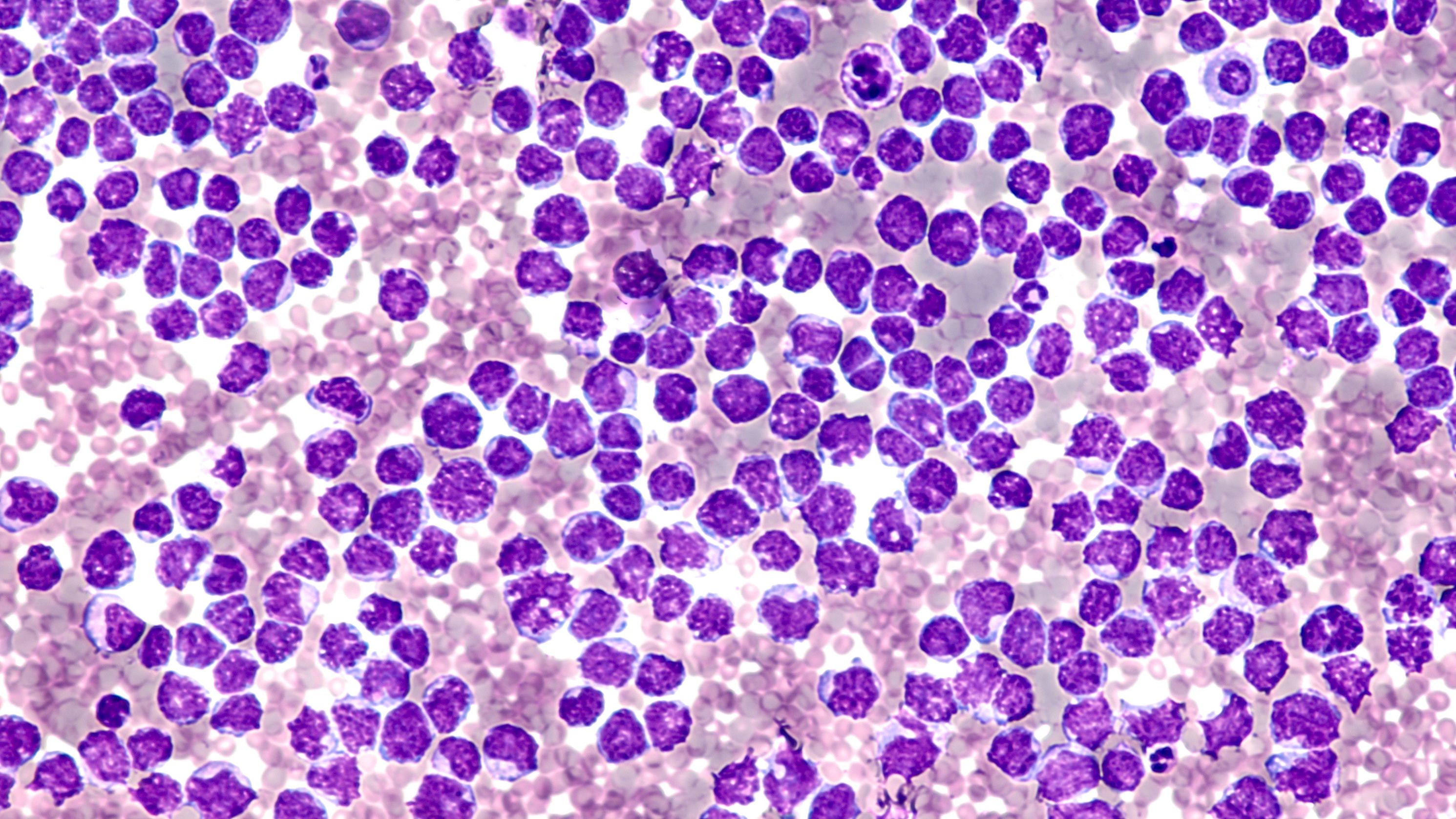Discussing The Role of Acalabrutinib in Triplet Therapy for MCL
In an interview with Targeted Oncology, Tycel Phillips, MD, discussed the initial results of the addition of acalabrutinib to bendamustine and rituximab to treat patients with mantle cell lymphoma.
Tycel Phillips, MD

The addition of the Bruton tyrosine kinase (BTK) inhibitor acalabrutinib (Calquence) to the combination of bendamustine (Bendeka) and rituximab (Rituxan) proved to be tolerable and effective enough to warrant expansion to a phase 3 trial for patients with either treatment-naive or relapsed/refractory mantle cell lymphoma (MCL).1
These data were presented at the 2023 American Society of Clinical Oncology (ASCO) Annual Meeting as part of a phase 1b study (NCT02717624) looking at the use of the novel BTK inhibitor in combination therapy. Acalabrutinib was previously approved as a single agent for patients with relapsed/refractory MCL,2 and now these results support the phase 3 ECHO trial (NCT02972840), which is comparing this triplet therapy against bendamustine and rituximab in this patient population. According to Tycel Phillips, MD, who presented these data at the ASCO meeting, this could represent a practice changing regimen if the phase 3 study results are positive.
At the meeting Phillips, a a hematlogist/oncologists in the Division of Lymphoma, Department of Hematology & Hematopoietic Cell Transplantation, and associate professor at the City of Hope National Medical Center in Duarte, California, discussed how the early efficacy signals show promise for patients that are traditionally ineligible for the use of autologous stem cell transplant (ASCT). Outcomes for these patients have taken strides in recent years, and results show acalabrutinib as part of triplet therapy could take those advancements further.
In a discussion with Targeted OncologyTM, Phillips highlights the key data from this study and the next steps heading into the ECHO trial, as well as what community oncologists should take away from these results.
TARGETED ONCOLOGY: What was the main focus of this study?
PHILLIPS: The focus of the study was the development of a phase 3 frontline study. If we look at frontline [treatment for patients with] MCL, especially for patients who are not thought to be eligible for autologous stem cell transplantation, treatment options are typically bendamustine and rituximab, typically given for 6 cycles followed by maintenance rituximab for 2 years. Additionally, a patient can also be treated with R-CHOP followed by maintenance rituximab and that maintenance rituximab period can go on for an indefinite period [of time] based on some of the studies from the German group.
For younger fit patients, or those considered to be transplant eligible, historically they had been [given] high dose chemotherapy followed by an ASCT and then 3 years of rituxumab maintenance. More recently with the new TRIANGLE study [NCT02858258], which looked at the addition of ibrutinib to frontline of immunochemotherapy, it appears that we may have a paradigm shift in how we treat at least young fit patients with newly diagnosed MCL.3 As of right now, I'm sure further follow up is needed here in the United States before that sort of changes our clinical practice.
Image Credit: © David A. Litman - www.stock.adobe.com

What was the design of the study looking into acalabrutinib?
The phase 1B study that we looked at was looking at the first trial to evaluate the safety and efficacy of acalabrutinib, which is a covalent BTK inhibitor given at 100 mg twice daily [with the] backbone of bendamustine and rituximab. As part of the study, patients received bendamustine on day 1 and 2 of every 28 days and follow it with rituximab on day 1 only. This was given for 6 cycles and patients were concurrently given 100 mg BID of acalabrutinib and this was continued until disease progression or intolerance. We had 2 separate cohorts, there was a treatment naive cohort which enrolled 18 patients and then a sort of relapsed/refractory cohort that enrolled 20 patients, again, evaluating for new safety signals and obviously getting a preliminary evaluation for efficacy and duration of response to this treatment regimen.
What were some of the key safety data from this study?
The key thing from the safety data is we didn't really see anything [that was] unexpected as far as toxicity profiles. There were no cardiac events that we noted of mention, we did have some of the same safety signals that we see with single agent acalabrutinib as far as onset of headache. With a combination of acalabrutinib and bendamustine rituximab there's a risk of infection due to the immunosuppressive event from both agents, but we did not see anything that was out of the ordinary that limited the safety aspect of this clinical trial. For the most part, [few] patients had to discontinue treatment for AEs that were noted on study. Overall, the safety aspect of this study was validation for the company to pursue a phase 3 study of this combination versus bendamustine and rituximab in the frontline patient population who were ineligible for ASCT.
Please explain some of the efficacy findings from this portion of the study.
[I'm happy to say that] the combination induced a very high overall response rate [ORR] and complete response [CR] rate, especially in the treatment naive cohort with a CR rate almost approaching 80%. The response rate in the treatment naive cohort was higher than what we saw in the relapsed refractory cohort, which is not unexpected given that in the relapsed/refractory cohort they're more resistant [to treatment].
These patients typically will have [more] background features that make them more difficult to treat, especially with subsequent chemotherapy. If we look at the median duration of response, again, it was much longer in the treatment naive cohort versus the relapsed/refractory cohort. But again, as I mentioned, as the main aspect of the study was really to evaluate the combination in the frontline setting of the trial itself, still supported that application of this combination in the frontline setting for these transplant ineligible patients.
What are the next steps for this treatment?
After this study completed, there was a launch of a phase 3 trial called ECHO, which evaluated bendamustine rituximab and acalabrutinib versus bendamustine rituximab for untreated patients with MCL who were 65 [years of age or older] who are typically considered to be ineligible for ASCT consolidation. That study did allow crossover for those in the bendamustine arm to crossover at disease progression to receive single agent acalabrutinib. At this point, we're just waiting to read out from that study, because that has been closed for a couple years just to see if this was a positive study or not. That takes on quite a bit more importance given what happened with the SHINE study [NCT01776840], which looked at a very similar BTK inhibitor in frontline MCL that ultimately led to the removal of that drug in the relapsed/refractory setting.4
What would you say is the takeaway of these data for community oncologists?
I think the key takeaways from this combination, at least this early phase study, was that the combination was safe and effective. How it compares to standard of care bendamustine rituximab is still something we need to tease out. Hopefully, the phase three study is positive and if that's the case, that will open up a new treatment option for patients in the frontline setting, who are thought to be ineligible for ASCT.... So, as we're all just patiently waiting for the results of that study to read out, just to know we have something new, that may be practice changing.
Reference:
1. Phillips T, Wang M, Robak T, et al. Safety and efficacy of ABR in patients with TN or R/R MCL: Phase 1B trial. Presented at: 2023 ASCO Annual Meeting, June 2-6th, 2023, Chicago, Illinois. Abstract 7546.
2. FDA grants accelerated approval to acalabrutinib for mantle cell lymphoma. FDA. October 31, 2017. Accessed: July 14, 2023. https://www.fda.gov/drugs/resources-information-approved-drugs/fda-grants-accelerated-approval-acalabrutinib-mantle-cell-lymphoma
3. Dreyling M, Doorduijn JK, Gine E, et al. Efficacy and safety of ibrutinib combined with standard first-line treatment or as substitute for autologous stem cell transplantation in younger patients with mantle cell lymphoma: results from the randomized Triangle trial by the European MCL Network. Blood. 2022;140(suppl 1):1-3. doi:10.1182/ blood-2022-163018
4. Update on IMBRUVICA® (ibrutinib) U.S. Accelerated Approvals for Mantle Cell Lymphoma and Marginal Zone Lymphoma Indications. AbbVie. News release. April 7, 2023. Accessed: July 14, 2023. https://news.abbvie.com/news/press-releases/update-on-imbruvica-ibrutinib-us-accelerated-approvals-for-mantle-cell-lymphoma-and-marginal-zone-lymphoma-indications.htm